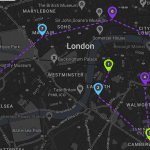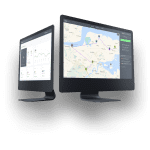**Updated 30th October 2023
Route optimization
Route optimization is determining the shortest possible routes to reach a location. This methodology has gained popularity in the transport and logistics industry. Since it reduces the time spent travelling and, at the same time, reduces the incurred cost in the process.
Before a company or an organization can employ this strategy, it must first be able to document all of its business routes, after which experts can then use the provided data to predict the best possible routes.
There is usually a simulation of different scenarios in determining the best possible routes. And ever since route optimization has gone digital with lots of software available today, the prediction of these routes is now done using the route optimization algorithm.
To better appreciate and understand what route optimization algorithm is expected to solve, knowledge of vehicle routing problems is important.
Vehicle Routing Problem
Whenever there is a discussion of vehicle routing problems, there is always a mention of the travel salesman problem (TSP). This problem is assumed to be the genesis of the vehicle routing problem.
First defined more than 150 years ago, the travelling salesman problem concerned how salesmen could visit each of their customers once through the shortest possible route and return to their starting destination.
Over time, as business strategy evolved, the travel salesman problem, now interpreted as the vehicle routing problem (VRP), has become more complex.
Vehicle Routing Problem, first published by George Dantzig and John Ramser in 1959, is concerned with the best optimal routes for vehicles to deliver to a specific group of customers.
Route Optimization Algorithm
The publication of George Dantzig and John Ramser in 1959 is the first documentation of using an algorithm to solve TSP. Route optimization algorithms are groups of computer permutations used to solve specific routing problems. These algorithms are designed differently to achieve certain leverage, such as reducing travel time costs or ensuring the maximal productivity of workers and trucks. Some algorithms may be designed to achieve all the stated leverage, while others may focus on a few or just one.
Dantzig and Ramser employed the algorithm to solve the gasoline delivery problem to service stations.
So, what is a route optimization algorithm?
A route optimization algorithm employs computational methods to find the most efficient paths for deliveries or vehicles in logistics or related activities. Factors like vehicle capacity, traffic, logistical limits, and delivery locations are considered. These algorithms vary in complexity, balancing computational speed and solution quality, but all aim to improve operations and boost customer satisfaction.
Different Applications of Route Optimization Algorithm
As stated earlier, applying a route optimization algorithm depends on the type of vehicle routing problem in consideration. Some of the VRPs that exist are;
Vehicle Routing Problem with Pickup and Delivery (VRPPD)
The problem in focus, in this case, is more similar to the general overview of route optimization. Certain goods are identified with the need to be delivered from a pick-up location. In this case, the algorithm aims to find the shortest possible route for vehicles to shuttle the pickup and delivery locations.
Vehicle Routing Problem with Time Windows (VRPTW)
In this scenario, the time frame to deliver is the primary consideration. Take, for instance, a logistics company with the promise of 24-hour delivery after an order will devise its algorithm to solve how the goods can get to the destination within the given timeframe.
Vehicle Routing Problem with LIFO
LIFO means Last In, First Out. The problem of any algorithm used in this context is similar to that of VRPPD, only that there is an attaching clause. The vehicle must be loaded with certain goods at any delivery location. To achieve this, the item to be delivered will be the one that was just added to the truck. The time spent unloading is aimed to reduce since only the recent ones will be dropped off.
Capacitated Vehicle Routing Problem (CVRP)
In this case, the devised algorithm is concerned with how the fleet of vehicles can be loaded with a specific amount of goods, no more, no less. And the delivery time and cost are improved at the same time with maximal productivity of drivers.
Vehicle Routing Problem with Multiple Trips (VRPMT) In this case, the algorithm is meant to focus on how a single truck can make more than one trip and remain effective in cutting cost, travel distance and better employee (drivers) productivity.
Open Vehicle Routing Problem (OVRP)
The open vehicle routing problem algorithm does not need to bother about the return of the vehicle to the pickup location. The optimization task ends as soon as the vehicle reaches the destination. Although this problem looks simple, it can be implemented complexly, such as making each trip a different route. The pickup to the delivery might be treated like a trip, while the return can also be treated the same in instances where the truck may deliver goods on its return.
Types of Route Optimization Algorithm
Each pundit’s perception determines the classification of the vehicle routing algorithm. This is why different scholastic publications can name the same thing with different names.
High Number of Stops Algorithm
This type of algorithm is used for route optimization with many numbers of stops ― more than 150. It is usually used in newspaper delivery, waste collection, postal deliveries, and a school bus. These stops are usually arranged to be closer to each other and also need to be visited at the same time.
Few Number of Stops Algorithm
The name says it all. It is the direct opposite of the high number of stops algorithm. The algorithm is programmed to tackle a route optimization problem with fewer than 150 stops. Things are, however, made more complicated in this case. The stops are not necessarily to be close to each other. They only have to share the time of need to visit.
Special Trip Interval Algorithm
The algorithm is expected to factor in the vehicle’s ability to make some interval trips to the destinations. For example, the vehicle may have 50 stops, and after every five stops, it is expected to make a different trip, such as visiting a filling station or grocery store to buy some stuff.
Route Optimization Algorithm and Big Data
For a successful algorithm implementation, it is required to note all involved data throughout the delivery system. This data may include;
- How frequently do customers order goods
- Statistics of customer’s order
- Areas with the most order and those with the least
- Number of vehicles available for delivery
- Geographical distance of pickup location to delivery
Some of these data are considered enough before the advancement of technology. Now, it is essential customers can track their orders. They need to know the current location and how long it will take to get to them. Aside from that, the algorithm needs to be improved from simulations to being capable of instant permutation in the real world.
All of these are only possible through integrating “big data”. Big data refers to a wide collection of data that can be used to improve how a company or software operate. Unlike conventional software analytics, big data is used to gather data that surpass what traditional software can handle, not even after multiple upgrades.
The gathered data are not mandatory to follow a specific pattern. A few years ago, all the unstructured data collected using big data-compatible software would have been considered useless. Another key point to note about big data is that they are gathered from multiple sources and stored in multiple formats.
For instance, big data may include a voice conversation of a customer representative with a customer and, at the same time, stored along with the tracking information of the ordered goods. It may go further by including other data like the signed receipt document and a picture of the order.
How Big Data Can Disrupt the Route Optimization Algorithm
An electronic appliance manufacturer can use big data to track their product’s performance in consumers’ homes. Whenever a product breaks down, the data is sent directly to the company through the embedded chip and a vehicle is scheduled to pick it up for repair even before the customer makes the call.
When there is a need for a vehicle to pick up a product from a particular location, big data can be employed to track the nearest vehicle, and the pickup information can be instantly relayed.
Another way big data can transform the route optimization algorithm is by correctly predicting the market trend (i.e., daily order rate). News data, past order trends, climate, and the state of the economy are vital information that can be collected to forecast future orders and, thus, proper algorithm preparation for handling the orders.
Even though conventional route optimization is effective to some extent in predicting the optimal route for vehicles, big data can detect the most efficient speed, time of the day, and fuel required to navigate these routes efficiently and probably even faster.
The use of route optimization has indeed disrupted how the delivery system is operated, saving companies extra costs and, at the same time, improving customer satisfaction. With the implementation of big data, the benefits experienced so far will be seen as the tip of the iceberg. Companies can discover the number of orders coming in the next day even when not in. They will also be able to gauge how satisfied their customers are and, on top of it all, monitor drivers’ progress.
This technological invention is a way to improve the customers’ experience at a lesser cost.
Want to try out GSMtasks’s route optimization? Give it a try! It’s free for the first 14 days!





